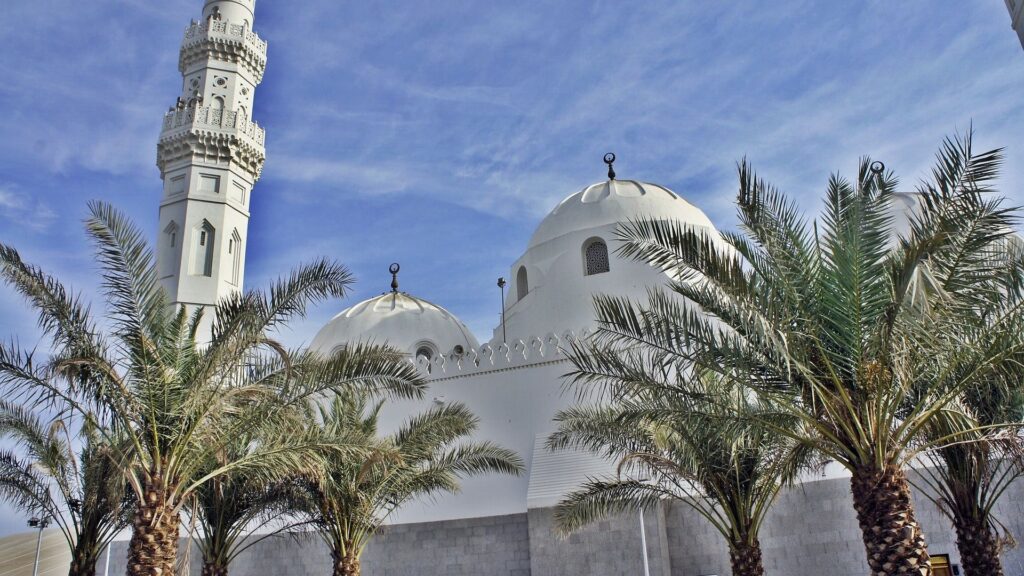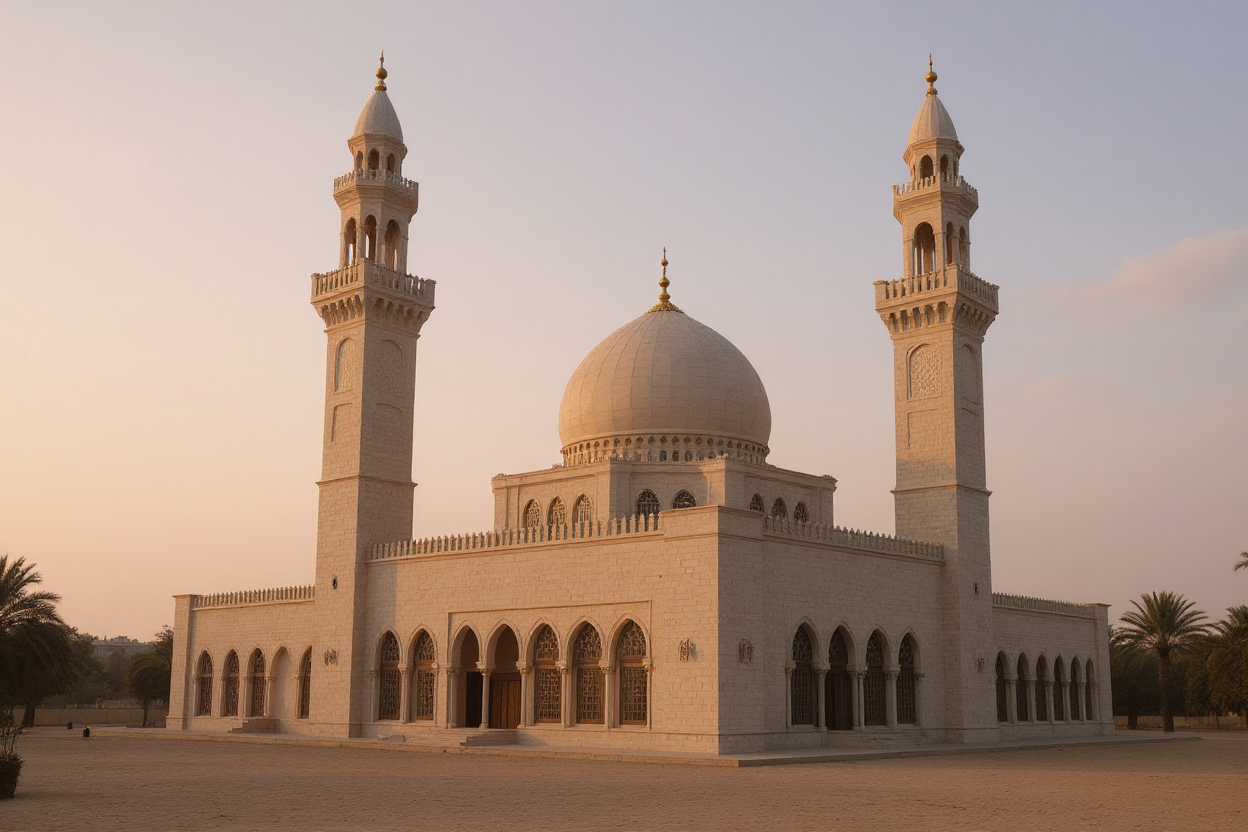Masjid al-Qiblatayn holds a special place in Islamic history because it witnessed one of the most significant moments in the life of the early Muslim community. This mosque became famous for the event when the qiblah direction changed from Masjid al-Aqsa in Jerusalem to the Kaaba in Makkah during a prayer led by the Prophet Muhammad. This moment marks a unique turning point in Islamic spirituality and identity, and it continues to inspire pilgrims, historians, and students of Islamic tradition.
Many people visit this mosque in Madinah to understand how a single moment reshaped the direction of Islamic worship forever. The mosque has been rebuilt several times, but its spiritual memory remains alive. Visiting Masjid al-Qiblatayn allows people to step into a place where history, revelation, and devotion came together in a powerful way, especially for travelers exploring Madinah through Easter Umrah Packages who wish to connect deeply with the roots of Islamic tradition.
What Is Masjid al-Qiblatayn

Masjid al-Qiblatayn literally means the Mosque of the Two Qiblahs. It received this name because Muslims prayed facing two different directions in the same place at different times. Before the change, the qiblah during prayer was toward Masjid al-Aqsa in Jerusalem. Later, through revelation, Allah commanded the Prophet Muhammad to turn the qiblah toward the Kaaba in Makkah.
The mosque originally belonged to the tribe of Banu Salamah, who lived in the outskirts of Madinah. Their area became the location where the famous shift occurred. Over time, the mosque gained recognition not only as a physical structure but also as a symbol of obedience, unity, and revelation. Today the mosque stands in a modernized form, yet the story behind it continues to inspire visitors.
How the Turning of Prayer Happened
The turning of the qiblah was a moment that took place during the prayer itself. According to reports, the Prophet Muhammad was leading the Zuhr prayer when revelation came instructing him to turn toward the Kaaba. He immediately changed direction and the companions followed. This change demonstrated the readiness of the early Muslims to obey divine instructions without hesitation.
This historical event is mentioned in the Quran in Surah al-Baqarah. It highlights not only the spiritual shift but also the unity and organization of the Muslim community. The companions did not question the instruction but acted at once. The entire rotation within the prayer became a remarkable example of discipline and devotion. The mosque’s role in preserving this moment remains valuable in the study of early Islamic identity.
Importance of Masjid al-Qiblatayn in Islamic History
Masjid al-Qiblatayn is important because it marks the moment when Muslims were given a new spiritual direction. This shift helped define the Muslim community as a distinct ummah. The change also strengthened the spiritual connection between Muslims and the Kaaba, which houses the symbol of monotheism established by Prophet Ibrahim and Prophet Ismail.
This historical transformation shaped Islamic rituals forever. Muslims in every part of the world follow the same direction during prayer, forming a unified spiritual posture. The origins of that unity can be traced back to this mosque in Madinah. Because of its significance, Masjid al-Qiblatayn continues to be an essential destination for pilgrims who explore Islamic heritage.
The Spiritual Meaning of the Qiblah Change

The change of qiblah carries deep spiritual meaning. It teaches believers that guidance comes directly from Allah, and that obedience is a core part of faith. This moment strengthened the idea that Muslims follow a path set by revelation rather than cultural or political influence.
In addition, the shift connected the growing Muslim community to the long tradition of Prophet Ibrahim. The Kaaba, built by Ibrahim and Ismail, became the center of worship. This link reminds Muslims of the history of monotheism and the responsibility of maintaining a sincere connection with Allah. Through Masjid al-Qiblatayn, this lesson remains clear and accessible to every generation.
The Architecture of Masjid al-Qiblatayn
Although the original structure built during the Prophet’s time no longer exists, the modern mosque still respects its historical roots. The government of Saudi Arabia renovated it to accommodate visitors and enhance comfort while preserving its heritage identity. The architecture features white stone, spacious halls, and arches that reflect traditional Islamic design.
Inside the mosque, visitors often feel a sense of calm that matches its historical importance. The simple yet elegant design encourages reflection. While the original two mihrabs from old times have changed through reconstruction, the memory of the event still stays alive through the mosque’s layout and educational features. This architectural blend ensures the story continues to be honored.
Visiting Masjid al-Qiblatayn Today
People visiting Madinah often include Masjid al-Qiblatayn in their itinerary. Many want to stand in the place where the companions stood when the qiblah changed. The mosque is easy to reach and is designed to welcome visitors from around the world. It feels peaceful compared to busier mosques, allowing time for reflection and learning.
Some visitors come with guided tours, while others prefer a quiet personal visit. The surrounding neighborhood is calm, and the environment helps create a spiritual atmosphere. Many people traveling through Umrah Packages 2026 also include this site in their itinerary because of its deep historical value. Visitors often reflect on how a single moment inside this mosque changed the direction of prayer for all Muslims. This experience adds depth to their journey.
Lessons From the Qiblah Change

The event of Masjid al-Qiblatayn teaches obedience to divine guidance. The companions changed direction instantly without confusion because their trust in Allah and His Messenger was complete. Their unity serves as a model for later generations. It shows that stability and strength come from following a clear spiritual path.
Another lesson from the qiblah change is understanding the continuity of Islamic history. The direction toward the Kaaba strengthens the bond with the legacy of Prophet Ibrahim. It also reminds Muslims that prayer is not just a physical motion but a deeply spiritual practice. The shift highlights that the heart and soul should always turn toward truth.
The Benefits of Learning About Masjid al-Qiblatayn
Learning about Masjid al-Qiblatayn helps deepen one’s understanding of Islamic history. It bridges the gap between the early days of Islam and the present era. People who study this mosque gain insight into the challenges and spiritual developments of the early Muslim community. This knowledge strengthens their connection to the Prophet’s life.
Another benefit is the feeling of unity that this story highlights. Muslims across the world face the same direction during prayer. Understanding where and how this unity began increases appreciation for the global connection all Muslims share. For many people, the story transforms their understanding of prayer into something more meaningful and purposeful.
Why the Two Qiblahs Matter Today
Although the event happened centuries ago, the memory of the two qiblahs still matters. It reminds Muslims that Islam is built on following revelation with sincerity. The direction toward the Kaaba continues to guide billions of worshippers every day. This unity starts with the moment captured in Masjid al-Qiblatayn.
The story also encourages people to remain flexible and open to guidance. Sometimes change is necessary for spiritual growth. The early Muslim community adapted immediately to the qiblah change, showing strength and maturity. This message continues to inspire modern believers facing new challenges.
Historical Narrations About the Qiblah Event

Islamic historians recorded several narrations that describe the turning of prayer. These narrations help preserve the details of the moment. Different companions shared what they saw and how the community reacted. Their accounts form a strong part of Islamic tradition and confirm the historical accuracy of the event.
These records also show how the qiblah change quickly spread throughout Madinah. In some mosques, people were informed of the revelation during prayer and they immediately shifted their direction. These narrations help us understand how deeply connected the Muslim community was to the Prophet’s guidance.
Masjid al-Qiblatayn in Pilgrimage Culture
Although most attention during Hajj and Umrah goes to Makkah, Madinah remains a key destination for visitors who want to learn Islamic history. Masjid al-Qiblatayn is one of the notable sites in the city. Many groups visit it along with Quba Mosque and Uhud Mountain. These places help enrich the learning experience.
Some pilgrims visit the mosque to reflect on unity and direction before continuing their journey. The environment helps them prepare spiritually. Many people say that standing in this mosque helps them understand the prayer in a new way. This reflection becomes an important part of their visit.
The Emotional Impact of the Mosque
Masjid al-Qiblatayn carries emotional weight for many visitors. The story behind it touches themes of trust, obedience, and community. People often feel thankful when they pray there, knowing they are connected to a moment that shaped the entire Islamic world.
Visitors frequently describe a sense of calm when they enter the mosque. The peaceful environment allows them to reflect on their own life direction. The turning of the qiblah becomes a metaphor for personal transformation. This emotional connection makes the visit memorable.
Masjid al-Qiblatayn in Islamic Education

Teachers use the story of Masjid al-Qiblatayn to explain important principles of faith. Students learn how revelation shaped the daily lives of early Muslims. The qiblah change demonstrates that Islam is a living religion guided step-by-step by divine wisdom.
Educational programs often include visits to the mosque or lessons supported by maps, diagrams, and narrations. These materials help students visualize the event. Learning about Masjid al-Qiblatayn through London Umrah Packages strengthens their knowledge and builds a deeper understanding of Islamic history.
The Connection Between Madinah and Makkah
The qiblah change strengthened the link between the two holy cities. While Madinah became the center of Muslim community life, Makkah remained the direction of prayer and the location of the Kaaba. This connection emphasizes harmony between the two cities.
The event illustrates that both places hold important roles in Islamic tradition. Visiting Masjid al-Qiblatayn reminds people of this relationship. It helps them appreciate how the two cities guide the spiritual journey of millions of Muslims.
Why Masjid al-Qiblatayn Should Be Preserved
Preserving historical mosques like Masjid al-Qiblatayn is important for future generations. These places help keep the stories of Islam alive. The lessons learned from them cannot be replaced by books alone. Being able to stand in the location where history happened adds depth to understanding.
Restoration and maintenance ensure that the next generation can experience the same spiritual atmosphere. These efforts also protect cultural and religious heritage. Masjid al-Qiblatayn deserves recognition not only for its past but also for its role in educating and inspiring people today.
A Short Conclusion
Masjid al-Qiblatayn stands as a reminder of a powerful moment in Islamic history. The turning of prayer changed the way Muslims worship forever and shaped the spiritual identity of the Muslim community. The mosque continues to inspire, teach, and connect people to the legacy of revelation. Its significance remains alive for everyone who visits or learns about it.
Sources
- Historic Accounts of the Qiblah Change by Early Islamic Historians
- Saudi Restoration and Architectural Reports on Masjid al-Qiblatayn
- Research on the Development of Madinah’s Historical Mosques
- Academic Paper on Early Islamic Urban Sites





